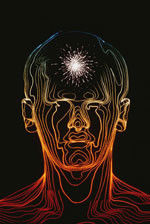Autism
Autism and the Brain Part 2
The second two neuroscience theories of autism.
Posted March 12, 2018 Reviewed by Abigail Fagan
I mentioned in the last blog entry that I wanted to give an overview of the most popular theories about the brain basis of autism. I wrote about two in the first post, and I'm going to write about the second two now.
In this post, I will review the theory of mind and mirror neuron hypotheses.

Theory of Mind
Theory of Mind (ToM) is our ability to understand the thoughts, feelings, and mental states of other people, and recognize that not everyone shares our mental state. As an example, pretend that you wake up and want cereal for breakfast. You open the cabinet and see a cereal box. You open it and start to pour it into a bowl. You then discover that there isn’t any cereal in the box—instead, the box is full of potato chips. Now, if someone asked you to predict what your spouse, friend, or neighbor will think is in the box when they want cereal, what would you say? Most likely, you recognize immediately that others will not know what you know about the cereal box—that he or she will expect there to be cereal in the box.
This might seem trivial, but neurotypical children have trouble answering this type of question correctly until they are 3 or 4 years old. Young children will think that everyone knows what they know—that the cereal box is full of potato chips. There is behavioral evidence that ToM is delayed in children with autism. The hypothesis is that children with autism have trouble understanding the thoughts, feelings, and intentions of others, which in turn causes social skills deficits. If you think about it, this makes sense. If you had difficulty understanding what other people are thinking and feeling, it would be hard to predict or understand the reasons behind people’s behaviors. This would make daily social interactions much more stressful and confusing, as well as lead to uncomfortable social interactions.
Studies of brain activity in individuals with and without autism show differences in both the location of brain activity and connection between brain areas when individuals with autism are asked to think about other people’s mental states. Overall, the theory of mind hypothesis says that the social skills difficulties experienced by people with autism relate back to problems with theory of mind.
![By Cgs [GFDL or CC-BY-SA-3.0], via Wikimedia Commons By Cgs [GFDL or CC-BY-SA-3.0], via Wikimedia Commons](https://cdn.psychologytoday.com/sites/default/files/styles/article-inline-half-caption/public/field_blog_entry_images/2018-03/mirror.jpg?itok=TfkCzCNS)
Mirror Neuron Hypothesis
Mirror neurons are brain cells that are active when we perform actions. Whenever you do something, your mirror neuron cells activate. What is interesting about these cells is that they also activate when you watch actions performed by others. For example, if you pick up a hairbrush or watch someone else pick up a hairbrush, your mirror neurons will activate. Imagine how useful those cells are: they help us predict other people’s actions, as well as with copying those actions by imitating them.
Imitation—copying the actions of others—is important, and is one of the ways children learn. If anyone reading this blog has children or younger siblings, you have probably observed this on many occasions. For example, there are many adorable videos and pictures of young children standing next to their father (or older sibling) as he shaves his face over the sink, putting shaving cream on their own face, and mimicking the action. There are others of children watching their mother or sister apply lipstick and using a toy to apply pretend lipstick to their own face. These are common examples of imitation. Mirror neurons are thought to be involved in imitation, and they might help us “translate” the actions of others to our own perspective. Along these same lines, mirror neurons are thought to be involved in understanding and predicting the actions of others.
Mirror neurons in autism have gained a lot of attention over the past 15 years. Brain activity studies have found that mirror neuron activity is altered in children with autism, which causes them to have trouble understanding others’ actions. When children with autism were shown pictures of people doing goal-directed actions (for example, grasping a mug to drink), they did not have trouble saying what the person in the photo was doing. However, when asked why the person in the picture was doing the action, they made errors.
When researchers measured muscle activity near the jaw, they found that neurotypical children activate their jaw muscles when observing other people reaching for food. This suggests that neurotypical children are predicting that the person is reaching for food with the intention of eating, and are mirroring the muscle movements necessary to open their own mouths. Essentially, even though the children aren’t eating, watching someone else reach for food causes them to engage their mouth muscles. They are imitating the muscle movement involved in the action they think the person they are watching will do—opening the mouth and eating. Children with autism did not engage their jaw muscles when observing someone reaching for (or grasping) food. This suggests that automatic imitation, or mirroring, does not happen when children with autism observe actions in others.
Overall, the idea behind the mirror neuron hypothesis of autism is that individuals on the spectrum might not have the same brain activity when watching the actions of others, which leads to problems understanding and predicting other people’s behavior. If the mirror neuron system is not functioning in autism the way it does for neurotypical individuals, it makes sense that both children and adults with autism would struggle to predict, understand, or imitate the actions of others. This would make social interactions confusing and unpredictable, which is reported by many children, teens, and adults on the spectrum.
Wrap up
I hope it was helpful to review and explain all four of these theories! These are not the only four neuroscience theories of autism, but they are ones that I notice being discussed often. For discussion of a fifth neuroscience theory, Psychology Today has a great discussion of the "Extreme Male Brain" Hypothesis.
References
Moran, J. M., Young, L. L., Saxe, R., Lee, S. M., O'Young, D., Mavros, P. L., & Gabrieli, J. D. (2011). Impaired theory of mind for moral judgment in high-functioning autism. Proceedings of the National Academy of Sciences, 108(7), 2688-2692.
Peterson, C. (2014). Theory of mind understanding and empathic behavior in children with autism spectrum disorders. International Journal of Developmental Neuroscience, 39, 16-21.
Frith, U., Morton, J., & Leslie, A. M. (1991). The cognitive basis of a biological disorder: Autism. Trends in neurosciences, 14(10), 433-438.
Baron-Cohen, S. E., Tager-Flusberg, H. E., & Cohen, D. J. (1994). Understanding other minds: Perspectives from autism. In Most of the chapters in this book were presented in draft form at a workshop in Seattle, Apr 1991.. Oxford University Press.
Mason, R. A., Williams, D. L., Kana, R. K., Minshew, N., & Just, M. A. (2008). Theory of mind disruption and recruitment of the right hemisphere during narrative comprehension in autism. Neuropsychologia, 46(1), 269-280.
Kana, R. K., Keller, T. A., Cherkassky, V. L., Minshew, N. J., & Just, M. A. (2009). Atypical frontal-posterior synchronization of Theory of Mind regions in autism during mental state attribution. Social neuroscience, 4(2), 135-152.
Oberman, L. M., Hubbard, E. M., McCleery, J. P., Altschuler, E. L., Ramachandran, V. S., & Pineda, J. A. (2005). EEG evidence for mirror neuron dysfunction in autism spectrum disorders. Cognitive brain research, 24(2), 190-198.
Dapretto, M., Davies, M. S., Pfeifer, J. H., Scott, A. A., Sigman, M., Bookheimer, S. Y., & Iacoboni, M. (2006). Understanding emotions in others: mirror neuron dysfunction in children with autism spectrum disorders. Nature neuroscience, 9(1), 28.
Cattaneo, L., Fabbri-Destro, M., Boria, S., Pieraccini, C., Monti, A., Cossu, G., & Rizzolatti, G. (2007). Impairment of actions chains in autism and its possible role in intention understanding. Proceedings of the National Academy of Sciences, 104(45), 17825-17830.
Boria, S., Fabbri-Destro, M., Cattaneo, L., Sparaci, L., Sinigaglia, C., Santelli, E., ... & Rizzolatti, G. (2009). Intention understanding in autism. PloS one, 4(5), e5596.


